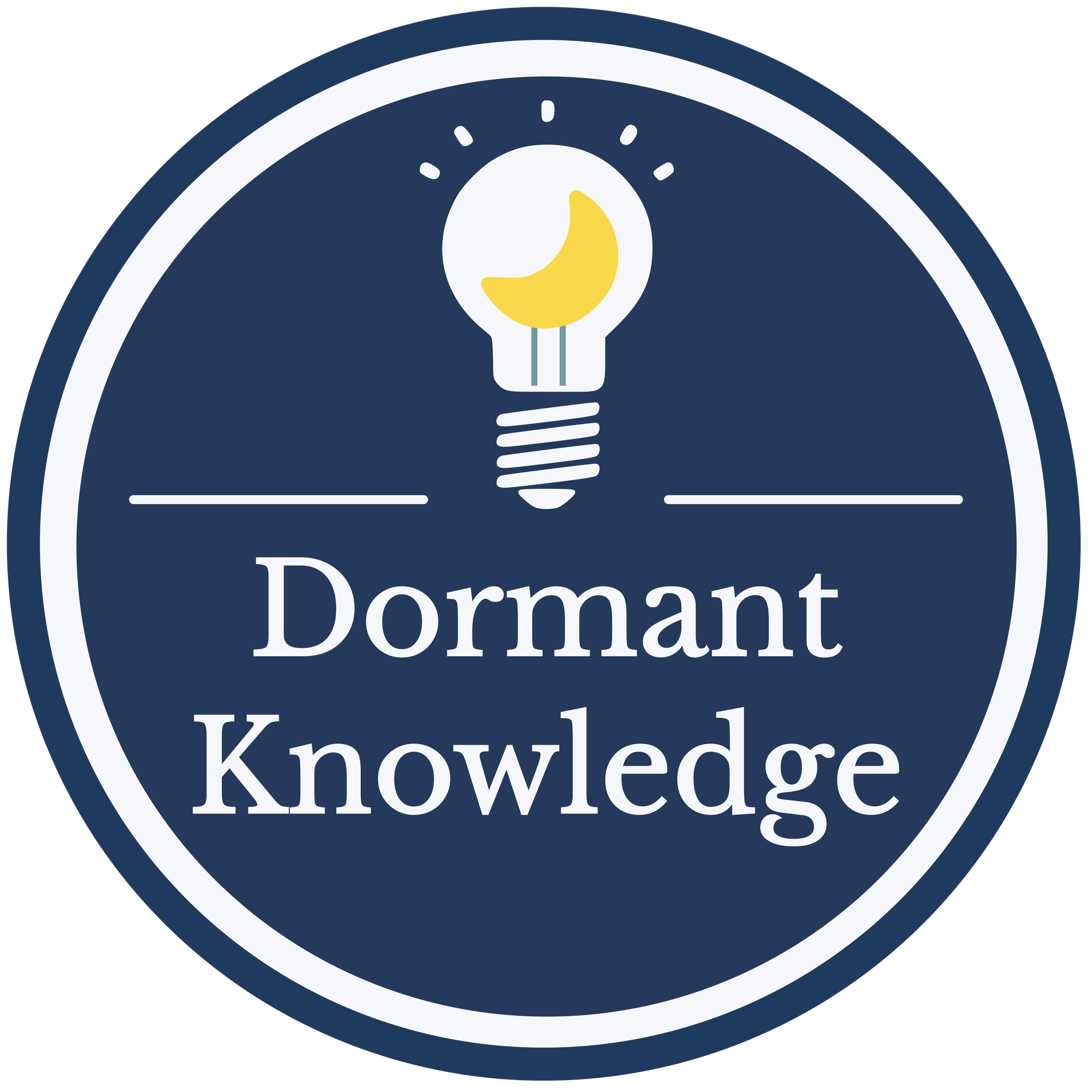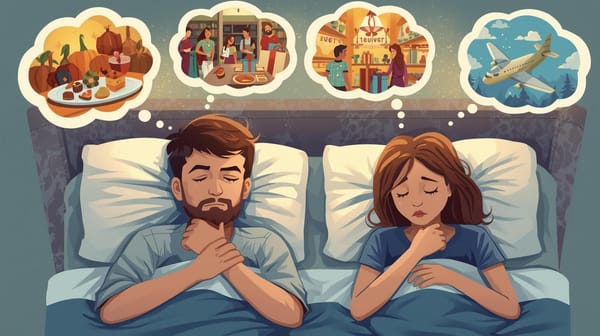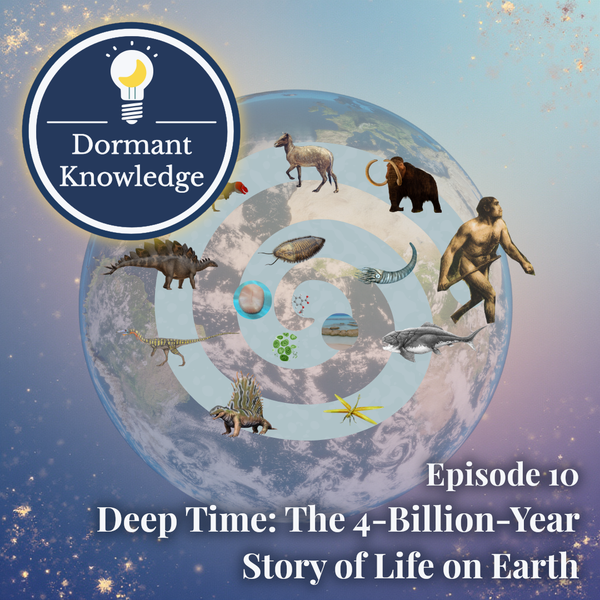The Science of 'Just Interesting Enough': Why Boring Content Doesn't Work for Sleep
How educational sleep podcasts find the sweet spot between engaging and overstimulating

How educational sleep podcasts find the sweet spot between engaging and overstimulating
What You'll Learn
- Discover why truly boring content fails as a sleep aid and often keeps you reaching for your phone
- Understand the psychological sweet spot between content that's engaging enough to quiet anxious thoughts but not so stimulating it prevents sleep
- Learn how educational content can occupy your mind without triggering the fight-or-flight response that keeps you awake
- Explore the neuroscience of attention, cognitive load, and sleep onset—and how they interact with audio content
- Understand what makes sleep podcasts different from both meditation apps and traditional podcasts
- See how narrative pacing, vocal delivery, and topic selection all contribute to effective sleep learning content
The Boring Content Myth
Here's a common assumption: if you want to fall asleep while listening to something, it should be as boring as possible. Monotone voice, dry subject matter, minimal variation in pace or tone. The audio equivalent of watching paint dry.
There's just one problem with this approach: it doesn't work.
If you've ever tried falling asleep to genuinely boring content, you know what happens. Your mind starts to wander. You become aware of every small discomfort. The pillow that's not quite right, the temperature that's slightly off. You start thinking about tomorrow's meetings, that conversation you wish you'd handled differently, your growing to-do list. And within minutes, you're reaching for your phone to find something—anything—more engaging.
The human brain doesn't do well with boredom. Research in cognitive psychology has demonstrated that when the brain lacks sufficient stimulation, it actively seeks out engagement, often in counterproductive ways. When lying in bed trying to sleep, an under-stimulated mind will either generate its own stimulation (usually in the form of anxiety-inducing thoughts) or drive you to seek external stimulation (hello, late-night social media scrolling).
So if boring content doesn't work, what does?
The Over-stimulation Problem
On the opposite end of the spectrum, we have content that's too engaging. True crime podcasts with cliffhangers. Comedy shows that make you laugh out loud. News programs that spike your cortisol. Mystery novels that make you desperate to know what happens next.
This type of content has its own problem: it activates rather than relaxes.
When content is highly stimulating, whether through emotional intensity, suspense, or intellectual challenge, it triggers increased activity in the brain's arousal systems. Your sympathetic nervous system engages, heart rate increases slightly, and dopamine and other alertness-promoting neurotransmitters are released. This is the opposite of the physiological state conducive to sleep onset.
Content with narrative tension is particularly problematic. Cliffhangers, unresolved mysteries, and high-stakes drama all create what psychologists call the Zeigarnik effect—the tendency to remember and mentally return to unfinished tasks or unresolved situations. This cognitive preoccupation can significantly delay sleep onset as the mind continues processing the incomplete narrative.
Similarly, content that requires active problem-solving or generates strong emotional responses works against sleep. If you're trying to figure out whodunit, or feeling anxious about a character's fate, or angry about an injustice being described, your brain is doing the opposite of what it needs to do to fall asleep.
Finding the Sweet Spot: The Goldilocks Zone of Sleep Content
So we need content that's not too boring (or we'll seek stimulation elsewhere) and not too exciting (or we'll never fall asleep). We need something just right.
This sweet spot has several key characteristics:
1. Intellectually Engaging Without Requiring Active Problem-Solving
The ideal sleep content should be interesting enough to capture and hold your attention, giving your mind something to focus on besides anxious thoughts. But it shouldn't require you to actively work to understand it or solve problems.
Research on cognitive load theory suggests that passive comprehension requires significantly less mental effort than active problem-solving, making it more compatible with the relaxed state needed for sleep.
This is why educational content about history, science, or culture works so well. Learning about the development of calculus, Pluto's discovery and subsequent controversial demotion, or how Tolkien and others developed Constructed Languages is inherently interesting. These are fascinating human stories with intriguing ideas. But you're not being asked to solve calculus problems, classify celestial bodies, or create your own language. You're simply absorbing information in a relaxed, receptive state.
2. Narrative Flow Without Artificial Tension
Good sleep content should have a natural narrative structure that gives your mind something to follow, but without the manufactured tension of traditional storytelling.
Historical and scientific topics have built-in narrative arcs. The story of Edison, Tesla, and the electrification of America unfolds naturally, with discoveries, setbacks, and eventual resolution—but these are historical facts, not cliffhangers designed to keep you on the edge of your seat. You're not desperately wondering what happens next; you're following a journey that happened long ago, with a comfortable emotional distance.
Our episode on Shakespeare's history plays demonstrates this perfectly—dramatic events from centuries past, compelling characters and conflicts, but delivered in a way that invites curiosity rather than anxiety.
3. Appropriate Pacing and Vocal Delivery
The speed and rhythm of speech significantly impact how content affects your state of arousal. Studies of speech patterns and relaxation have shown that slightly slower speech rates, with natural pauses and a conversational tone, promote relaxation more effectively than either very fast speech or artificially slow, monotone delivery.
This is one of the key differences between sleep podcasts and traditional meditation apps. Meditation apps often feature very slow, deliberately peaceful voices that some people find helpful but others find artificially soporific or even irritating. Sleep podcasts, on the other hand, use a natural conversational pace—just slightly slower than normal speech, with a warm, engaging tone that mimics someone sharing fascinating information over coffee, not someone trying very hard to make you relax.
The goal is to sound like a knowledgeable friend who's genuinely interested in the topic, not like someone performing "sleepiness" at you.
4. Topic Selection That Balances Curiosity and Calm
Not all interesting topics are equally suitable for bedtime listening. Content that triggers strong emotions, whether fear, anger, or excitement, works against sleep. Similarly, topics that are too personally relevant can engage the problem-solving parts of your brain. (Career advice or financial planning podcasts, however well-delivered, are unlikely to help you drift off.)
The most effective sleep learning topics tend to be:
- Historically removed: Events from the past that we can learn from without emotional urgency
- Intellectually curious: Topics that satisfy the desire to learn and understand
- Emotionally neutral: Fascinating without being anxiety-inducing
- Self-contained: Each episode explores a complete topic, so there's no pressure to continue
This is why topics like the history of television standards like NTSC and PAL or different musical tuning systems work so well. They're genuinely interesting: There are surprising discoveries, human stories, and "aha" moments. But they're not going to spike your adrenaline or keep you awake worrying.
5. Permission to Drift
Perhaps the most important element of effective sleep content is the explicit permission—even encouragement—to drift off before the end.
Traditional podcasts want you engaged from start to finish. They build to climaxes, save the best for last, and use techniques to retain your attention throughout. This is exactly wrong for sleep content.
Educational sleep podcasts succeed when they remove performance pressure. There's no quiz at the end, no critical information saved for the conclusion that you'll miss if you fall asleep. The content is structured so that drifting off at any point is not just acceptable—it's actually the intended outcome for most listeners.
This permission to disengage is psychologically powerful. When people feel they "should" stay awake to finish content, it creates a mild stress response that can paradoxically prevent sleep. Removing this pressure allows the mind to relax more fully.
The Neuroscience of the Sweet Spot
Understanding why this sweet spot works requires looking at what's happening in your brain as you fall asleep.
Sleep onset involves a gradual transition from wakefulness to sleep, regulated by the interaction of several neural systems. The ascending arousal system, centered in the brainstem and hypothalamus, promotes wakefulness, while the ventrolateral preoptic nucleus (VLPO) promotes sleep. The balance between these systems determines your state of consciousness.
For sleep to occur, the arousal system must quiet down and the sleep-promoting system must gain dominance. This process is hindered by both under-stimulation and over-stimulation:
Under-stimulation leaves the default mode network—the brain's "idle" state—free to generate its own content, often in the form of rumination, worry, or planning. These internally-generated thoughts can be more arousing than external content, particularly for people with anxiety or racing thoughts.
Over-stimulation directly activates the arousal system, releasing neurotransmitters like norepinephrine, dopamine, and cortisol that promote wakefulness and make sleep onset difficult or impossible.
Optimal sleep content provides just enough external stimulation to occupy the default mode network (preventing rumination) without activating the arousal system (preventing increased wakefulness). It's like giving your mind something gentle to hold onto as you drift off, rather than leaving it to grasp at anxious thoughts or forcing it to grip tightly to exciting content.
Research on audio stimuli during sleep onset has demonstrated that content with moderate semantic complexity—meaningful but not demanding—can actually facilitate the transition to sleep by occupying cognitive resources that might otherwise be directed toward arousal-inducing thoughts.
Why Educational Content Occupies the Sweet Spot
Educational content about history, science, or culture naturally occupies this Goldilocks zone for several reasons:
Inherent Interest Without Personal Stakes: Learning about the economic principles illustrated in "I Pencil" is intellectually engaging, but it doesn't trigger the fight-or-flight response the way a thriller would. You're curious, but not anxious.
Cognitive Engagement Without Cognitive Demand: Following an explanation or story requires attention, but not active problem-solving. Your mind is occupied but not working hard.
Natural Resolution: Historical events and scientific discoveries have natural endpoints. The story concludes, but gently, without artificial cliffhangers.
Emotional Distance: Events from the past or abstract scientific principles don't trigger the same emotional intensity as contemporary issues or personal problems.
Repetition and Redundancy: Good educational content naturally includes repetition and multiple ways of explaining concepts. This reinforces learning while also creating a gentle, circular quality that suits the drifting nature of falling asleep.
This is why space topics like Pluto's story work particularly well for sleep learning—they're far enough removed from daily concerns to feel relaxing, but close enough to human experience (the scientists, the debates, the discovery process) to remain engaging.
How This Differs From Meditation Apps
It's worth distinguishing sleep podcasts from meditation apps, as they serve related but different functions.
Meditation apps and sleep podcasts take fundamentally different approaches to the same goal. Meditation apps typically use one of several techniques:
- Guided relaxation: Progressive muscle relaxation, body scans, or breathing exercises
- Ambient sounds: Rain, ocean waves, white noise, or other consistent soundscapes
- Sleep stories: Deliberately slow, soothing narratives designed to be as calming as possible
These approaches work for many people, particularly those who respond well to direct relaxation techniques. But they can fall short for people whose minds resist being explicitly told to relax, or who find ambient sounds either boring (leading to rumination) or slightly annoying (leading to irritation rather than sleep).
Some individuals, particularly those with more active or analytical minds, find that direct relaxation instructions create performance pressure—the sense that they should be relaxing "correctly"—which paradoxically increases arousal.
Educational sleep content works differently. Instead of telling you to relax, it simply gives you something interesting but unstressful to think about. Your mind naturally settles into a receptive, learning state, which happens to be quite compatible with sleep onset. You're not trying to relax; you're just listening to something interesting. The relaxation happens as a side effect, not as the direct goal.
You can read more about this difference in our blog post dedicated to the subject:
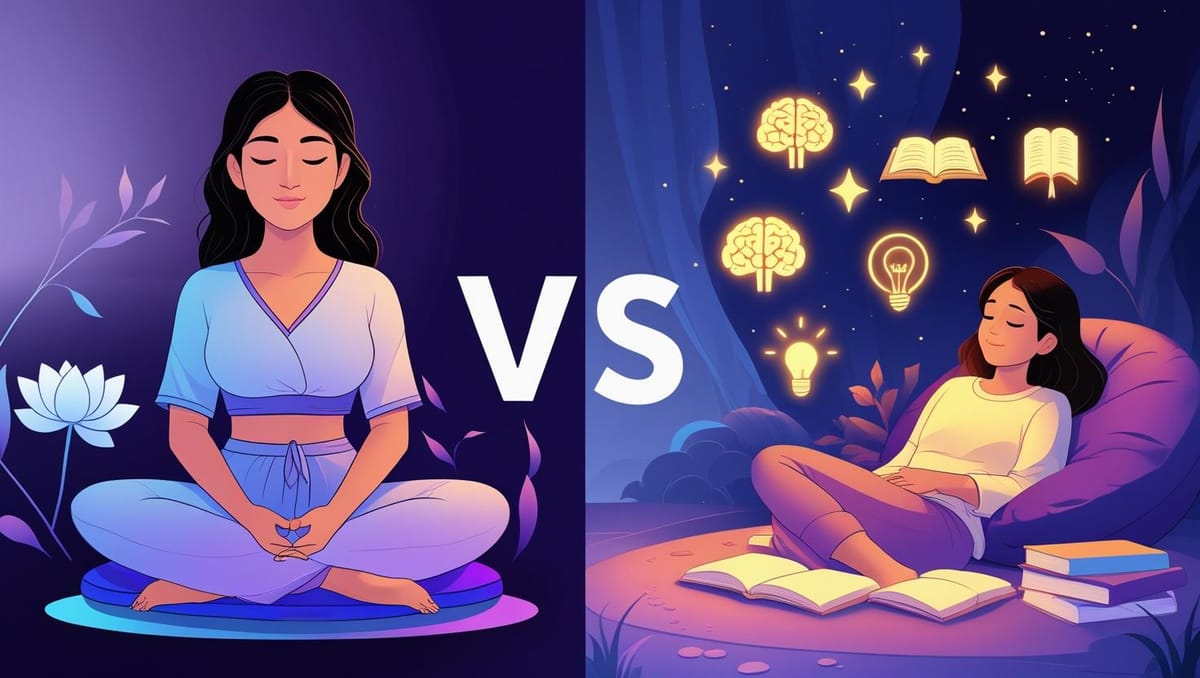
Calibrating Content: The Art and Science
Creating content that hits this sweet spot consistently requires careful calibration across multiple dimensions:
Vocal delivery: Conversational but slightly slower than normal speech, with natural pauses and a warm tone. Not monotone (too boring) but not overly animated (too stimulating).
Topic complexity: Complex enough to be intellectually satisfying, but explained clearly enough that understanding doesn't require hard mental work. The listener should feel like they're learning, not studying.
Emotional valence: Fascinating and sometimes surprising, but avoiding strong negative emotions (fear, anger, disgust) or highly arousing positive emotions (excitement, suspense).
Narrative structure: Beginning, middle, and end, but without building to a dramatic climax. Think gentle hills rather than steep mountains.
Content density: Substantial enough that there's always something to engage with, but with enough pauses, tangents, and repetition that the mind can wander without losing the thread entirely.
Sound design: Minimal and unobtrusive. Gentle music transitions, natural ambient sounds if appropriate, but nothing jarring or attention-grabbing.
The science of sleep learning shows that we can absorb information even in drowsy states, so educational sleep content serves a dual purpose: occupying the mind to facilitate sleep onset, and actually teaching something in the process.
Practical Implications
Understanding the sweet spot of sleep content has practical implications for anyone struggling with sleep or looking to make their bedtime routine more productive:
If you're currently using white noise or ambient sounds and finding them insufficient, try educational sleep podcasts. Your mind may need more structure and interest than ambient sounds provide.
If you're currently listening to regular podcasts and finding you can't fall asleep, the content is probably too engaging. Look specifically for content designed for sleep, with appropriate pacing and permission to drift off.
If you've tried meditation apps and found them frustrating, you may be someone whose mind resists direct relaxation instructions. Educational content gives your mind something to do that's compatible with sleep without explicitly trying to make you relax.
If you find yourself reaching for your phone when you can't sleep, having a sleep podcast queued up and ready to play can provide the stimulation your mind is seeking without the blue light and endless scrolling that will keep you up even longer.
Good sleep hygiene remains important—consistent sleep schedule, comfortable sleep environment, limiting screens before bed—but for many people, the right audio content can be the missing piece that finally allows them to quiet their racing thoughts and drift off.
The Future of Sleep Content
As our understanding of the neuroscience of sleep improves, and as more people discover that the right kind of content can actually facilitate rather than hinder sleep, we're likely to see continued innovation in this space.
The key insight—that content should be "just interesting enough"—points toward a more sophisticated understanding of how we can use our modern abundance of information and entertainment not just to fill waking hours, but to ease the transition into restorative sleep.
Because in the end, the goal isn't to be bored to sleep or forced into relaxation. It's to give your curious mind something gentle to hold onto as you drift away, something that satisfies your desire to learn and grow even as your body gets the rest it needs.
That's the sweet spot. Not too boring. Not too exciting. Just interesting enough.
Further Reading
Scientific Sources:
Baddeley, A. (2003). "Working memory: looking back and looking forward." Nature Reviews Neuroscience, 4(10), 829-839. [Research on cognitive load and information processing]
Saper, C. B., Scammell, T. E., & Lu, J. (2005). "Hypothalamic regulation of sleep and circadian rhythms." Nature, 437(7063), 1257-1263. [Neuroscience of sleep-wake regulation]
Vyazovskiy, V. V., & Harris, K. D. (2013). "Sleep and the single neuron: the role of global slow oscillations in individual cell rest." Nature Reviews Neuroscience, 14(6), 443-451. [Neural mechanisms of sleep onset]
Zeigarnik, B. (1938). "On finished and unfinished tasks." A source book of Gestalt psychology, 300-314. [The Zeigarnik effect and cognitive preoccupation]
Sleep and Learning:
Born, J., & Wilhelm, I. (2012). "System consolidation of memory during sleep." Psychological Research, 76(2), 192-203. [How sleep facilitates memory consolidation]
Rasch, B., & Born, J. (2013). "About sleep's role in memory." Physiological Reviews, 93(2), 681-766. [Comprehensive review of sleep and learning]
Related Dormant Knowledge Content:
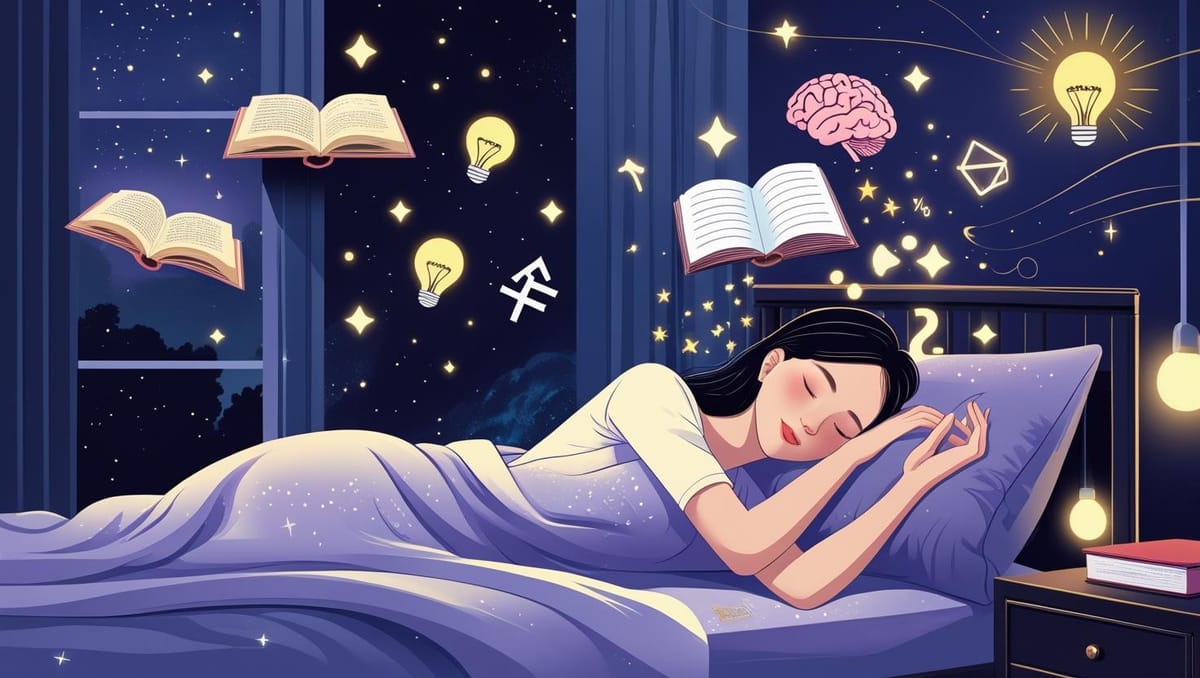
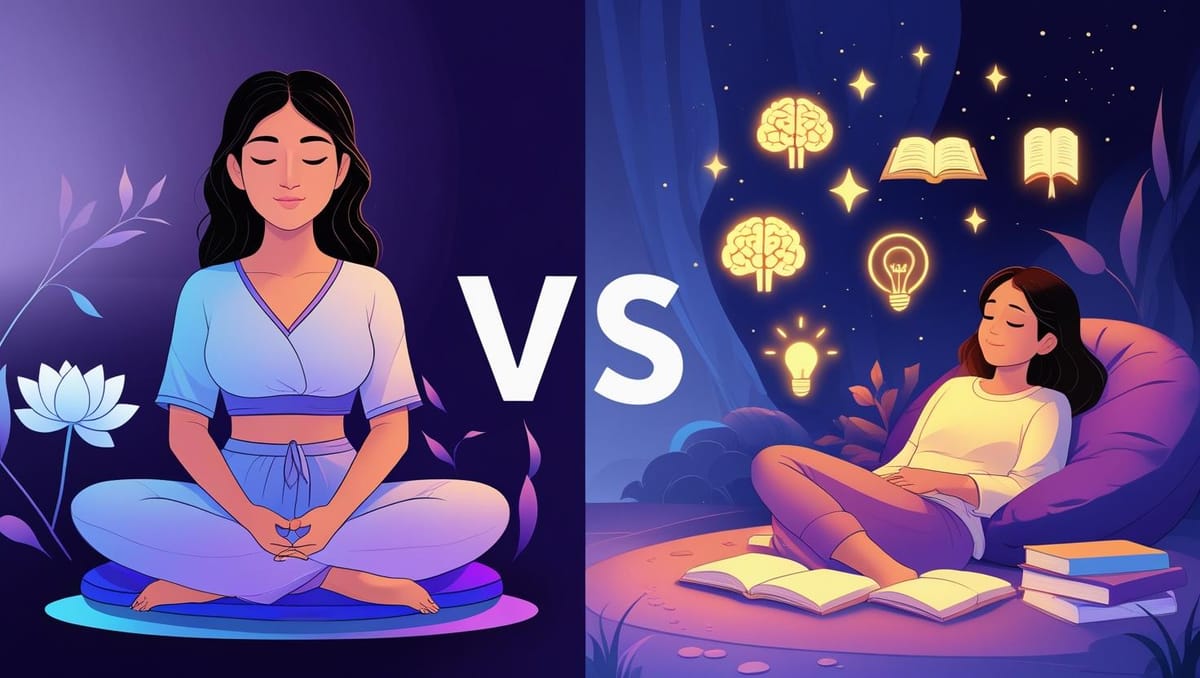


Dormant Knowledge is an educational sleep podcast for curious minds. Find us at dormantknowledge.com or on all major podcast platforms.
